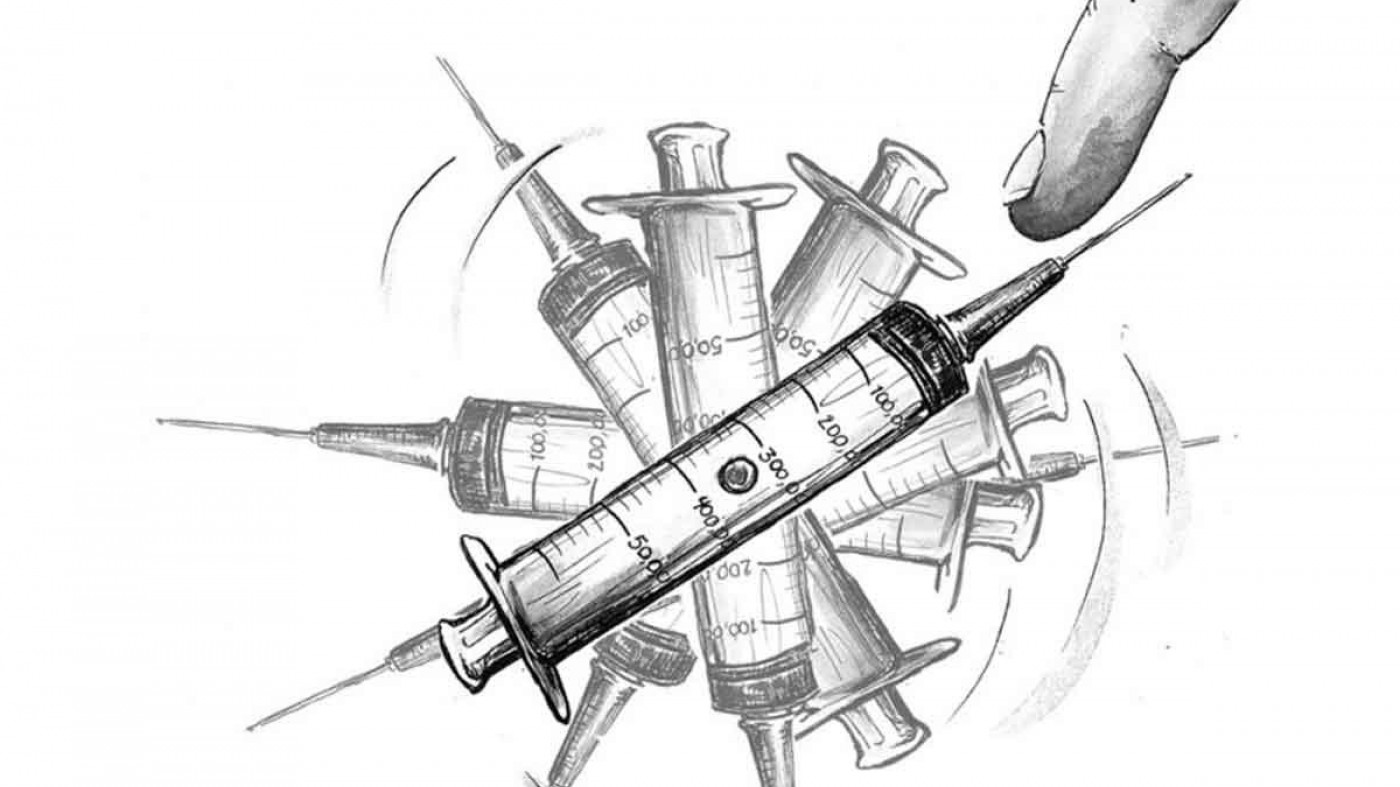On the Prairies, the drug crisis is not opioids, but meth

Aimée van Drimmelen
In September 2019, harm reduction worker and public health researcher Gillian Kolla told Global News the opioid crisis was “the largest health crisis of our generation.” Although opioid use in Canada is dropping – medical use has decreased over the past five years, and abuse of opioid pain relievers decreased slightly from 2012 to 2017 (the most recent year from which data is available) – hospital admissions for opioid poisoning have been on the rise, along with overdose deaths. This is mostly due to the increasing availability of powerful synthetic opioids like fentanyl and carfentanil, which are more potent – and deadlier – than opiates like morphine, codeine, and heroin.
Provinces including Saskatchewan have started training programs on how to administer Naloxone, an opioid blocker that can reverse the effects of an overdose, for people in the community who have close contact with opioid users. All four of the major party leaders in the 2019 federal election had some kind of opioid strategy as part of their campaign platforms, and in 2018 the federal government entered into a bilateral agreement with Saskatchewan to ensure targeted funding to deal with the crisis. There were 114 opioid-related deaths in Saskatchewan in 2018, and the province saw the biggest jump in fentanyl-related deaths in the country. The need for a strategy to deal with the problem can’t be overstated. But opioids aren’t the primary drug of choice in Saskatchewan. Stimulants – like cocaine and meth – are. Of all Saskatchewan residents seeking treatment for addiction, the number accessing treatment for meth addiction rose from 3 per cent in 2012–13 to 30 per cent in 2017–18. That’s a 10-fold increase in five years. And almost everything about stimulants – from the effects they produce to the societal response they elicit, to the treatment that’s available – differs from opioids, so a strategy for one cannot be assumed to work for the other.
Almost everything about stimulants – from the effects they produce to the societal response they elicit, to the treatment that’s available – differs from opioids
Dr. Ginette Poulin, a general practitioner and addictions medicine specialist in Manitoba, says that there are multiple possible reasons for the surge in meth use in the Prairie provinces and that it’s not unusual for a community’s drug of choice to fluctuate over time. “Meth can go for about $10 a point [dose] whereas opioids could be $50 for 80 mg [OxyContin]. When you look at the price point, that’s definitely a factor,” Poulin says. In November 2019, the Saskatoon Police Service said that the price of a dose was as low as $3. Add that to the fact that a methamphetamine high can last anywhere from 8 to 24 hours, while an opioid high usually lasts for just 2 to 5 hours, and opioid users have to dose again within 6 to 12 hours to avoid symptoms of withdrawal.
Onyeka Arinze of the Métis Addictions Council of Saskatchewan Inc. (MACSI) agrees that the low cost of crystal meth has contributed to its prevalence, but says that the increasing frequency with which drugs are being laced has made the term “drug of choice” a misnomer. “Clients [are] becoming poly-dependents,” she says. “They’re addicted to more than one drug at a time.” Poulin says dealers have an incentive to spike their product with other, more potent substances, like adding fentanyl to morphine or crystal meth to cocaine. “They want to create a product that will be [something] that people will want. Things that will take effect faster and have a longer half-life,” she says.
Poulin adds that price and potency – and the increased prevalence of poly-dependence from laced drugs – are far from the only factors. “It can be almost a survival need on the street. […] If someone doesn’t have a home, taking a stimulant to keep themselves awake and alert” makes sense, she says. Taking a stimulant means “I can fend for myself on the street, I can defend myself if someone was going to jump me or rape me,” she explains.
It’s an interesting counter to Manitoba premier Brian Pallister’s 2018 statement that “Manitobans who don’t choose to use crystal meth or any other drug should not feel unsafe in their own province.” From Poulin’s perspective as a health-care practitioner, the conditions facing unhoused people have some Manitobans choosing to use crystal meth so they can feel safe in their own province. Like methamphetamine use, homelessness in Winnipeg is rising, and the city has chosen to respond to the crisis with increased policing instead of investing that money into affordable housing and social services.
Taking a stimulant means “I can fend for myself on the street, I can defend myself if someone was going to jump me or rape me.”
The link between crystal meth and the safety of users and the public means that methamphetamines are a major factor in rapidly increasing police budgets across the Prairies – in Regina as well as in Saskatoon, which had the second-highest number of meth possession arrests in the country, well ahead of Vancouver and behind only Edmonton. Both Saskatoon police chief Troy Cooper and Regina police chief Evan Bray have cited an increase in meth-related crime in their successful appeals for more funding from city hall. Unlike opioids, which cause sedation, meth can drive its users into a frenzy. “What can happen with individuals who use stimulants is it affects a part of the brain where they get a lot of paranoia and agitation, and anything in the environment can set them off and they can be quite dangerous to themselves or others,” says Poulin. She adds that the ease with which people can make meth using “backyard chemistry” is leading to an increase in the potency of the drug – and the aggressivity it induces.
“If there was an easy solution, we would have already fixed the problem,” Poulin says. In the meantime, Saskatchewan has mostly defaulted to law enforcement responses. In 2019, Bray defended the increase in the police budget to the Sask Dispatch, saying “no one else at 2 o’clock in the morning is going to go and deal with a volatile person in a house with a knife who’s under the influence of drugs or alcohol.” He added that if a social justice alternative to policing drug users – like decriminalization – was implemented, “we had better make sure that we’re funding properly […] all of the front-line services and supports that go with it. To make sure that we have rapid triage to ensure that we can deal with these [issues] in a very swift and immediate way.”
It seems that even Regina’s chief of police understands that addiction is the kind of social crisis that could be treated by a completely different framework than the one that’s in place now, if only there were money for it. Calgary’s interim police chief, Steve Barlow, similarly told a House of Commons health committee that “we will not arrest our way out of this problem.” The issue, then, is not “should we treat addiction as a health crisis?” but rather, “are we willing to fund addiction as though it is a health crisis?” And right now, the answer to that question is a resounding “no.” According to Poulin, mental health and addictions treatment only accounts for about 7 per cent of health-care funding nationwide, and in Saskatchewan, the picture is even grimmer.
In 2017–2018, the province spent less per capita on mental health and addictions treatment than any other province in the country. Total spending has increased by $29.8 million since 2018, but Danielle Chartier, NDP critic for mental health and addictions, says that number is misleading: according to the CBC, $14 million of that is designated for staffing Saskatchewan Hospital North Battleford. She says the real number the province has budgeted for new mental health and addictions initiatives is actually $9.85 million – the remaining $6 million “is federal dollars,” she says. This money comes from the Emergency Treatment Fund Bilateral Agreement that the federal government signed with the province – an agreement that mentions opioids 24 times before the words “crystal meth” enter the equation.
In 2017–2018, the province spent less per capita on mental health and addictions treatment than any other province in the country.
“It’s better than nothing,” Chartier says of the 22 new in-patient beds that have opened across the province. But she adds that, “prior to this budget, we had fewer beds for addictions treatments than we did in 2013–14: 364 treatment beds [before 2015] to 356 right before this budget […] that doesn’t put us too far ahead in treatment when you’ve got people waiting for three to eight weeks” to get into a 28-day treatment program, which Poulin says is the norm. And 28 days isn’t the length of stay dictated by medical best practices – it’s simply the maximum amount of time that most insurance companies are willing to pay for treatment. But even that length of time receiving in-patient care is utopian in comparison with the vacuum of services that awaits people when they get out, especially for people who use stimulants.
Although it’s become more common for health-care providers to use pharmacotherapies – namely, drugs like methadone and naltrexone – to manage patients’ addictions to opioids and alcohol, no such pharmaceutical therapy exists for people who are addicted to stimulants. That means that when someone comes out of treatment for a meth addiction, there are limited options for ongoing care. Poulin says that “with methamphetamines, what has shown to be the most effective [treatment] is a very intensive psychotherapy: in-house kind of treatment where you start with a lot of localized support, ongoing cognitive behaviour therapy, dialectical behaviour therapy, [and] coping skills for a longer term.”
What people get instead is a patchwork of programming that largely depends on where they live. For people with addictions living in Saskatoon, there is MACSI’s day program, which, Arinze says, “follows a harm reduction model [and] includes resource days, where outside organizations come in to speak to clients about other organizations [and] services available to them.” The program runs on a six-week rotating basis from 1 p.m. to 4 p.m. each weekday. “The majority of professionals in the addiction field recognize that we are under-resourced in tackling the drug epidemic,” Arinze says. “The amount of people identifying as having an addiction is multiplying at a faster rate than the existing resources and helping professionals available to them. While Saskatoon is slowly integrating new services, it does appear we are operating at an interventionist approach as oppose[d] to prevention.”
“The amount of people identifying as having an addiction is multiplying at a faster rate than the existing resources and helping professionals available to them.”
And for folks outside Saskatoon, the lack of professional services is even more stark. There is Alcoholics Anonymous (AA) and Narcotics Anonymous (NA). While members may not be barred from attending meetings when they have used, the goal of both programs is complete abstention from all substances. SMART Recovery, one of the few alternatives to 12-step programs like AA and NA, which offers meetings in some of Saskatchewan’s larger centres, isn’t abstinence-based. But SMART meetings are facilitated by volunteers who are not necessarily health-care professionals.
People with addictions may find themselves caught up in the criminal justice system, something that Poulin thinks can facilitate recovery. She points to the Winnipeg Drug Treatment Court, where people who have been charged with drug offences can be diverted from the criminal justice system and into provincial treatment centres, as one example.
But the reality of drug treatment court is that it’s just like any other criminal court. “They have accountability to the legal system,” Poulin says of people who go through drug treatment court. While on a surface level that may seem just and fair – after all, we’re all accountable for our actions, and people end up in drug treatment court because they’ve violated a law – it’s actually a perverse system in which the individual is legally accountable to the same state upon which they depend for medical treatment. That is to say, if the medical treatment the state provides to the individual is inadequate, or otherwise fails to provide the intensive, holistic care required to treat a chronic condition like addiction, it is the patient who pays the price.
Saskatchewan has a drug treatment court as well – and it comes with caveats. People can only go through drug treatment court once. If they get caught with drugs a second time, they’re back into the criminal justice system. Given that addiction is a chronic condition that may include periods of relapse and recovery, the “one strike and you’re out” model of drug treatment court doesn’t effectively divert drug users from incarceration. Similar disconnects between the demands of the justice system and the realities of addiction can be seen in parole conditions that require parolees to submit to drug testing, and stipulate a return to jail if they fail to stay off drugs.
If the medical treatment the state provides to the individual is inadequate, it is the patient who pays the price.
These kinds of rigid conditions for people convicted of drug offences can have tragic outcomes. Josephine Pelletier – a Cree and Saulteaux woman from Regina whose death I reported on for Briarpatch in January 2018 – committed almost all of the crimes for which she was convicted either under the influence of drugs or in pursuit of money to pay for them. During her brief periods of relative freedom, she was subject to conditions that required her to abstain from drugs. When she could not, she was sent back to prison, a cycle that lasted her entire adult life and only ended when she was shot to death by Calgary police in May 2018.
Poulin says that in the same way people with substance-use disorders need holistic treatment in order to get better, so too does the system need a multi-faceted approach to be repaired. “When we talk about addictions, it’s not just the health sector,” Poulin says. “We need to beef up things like education. […] We need to think about what we need to do to make families healthier.” Tackling a drug crisis also means ending cycles. “It’s really important not to forget the social reasons that people use,” Poulin says, “which might be mental health, childhood trauma, intergenerational trauma, a parent taken to jail.”
This means moving away from the abstinence-versus-harm reduction dichotomy. Abstinence-based responses can be seen as paternalistic; they insist that there is only one way to deal with addiction and that users are not individuals, but a monolith whose illnesses can be treated by a universal protocol – simply saying “no.” “We need to offer the spectrum of care that is offered for all other [illnesses],” Poulin asserts. “We need to advocate for more funding [because] the reality is we’re facing addictions issues in all areas: health care, justice, education systems. And if we don’t invest more in [addictions] we’re going to see this problem grow and it’s going to cost more.”
“We need to offer the spectrum of care that is offered for all other [illnesses].”
Incremental progress is being made in some areas of the province. In August, AIDS Saskatoon announced that they had received Health Canada approval for a safe injection site. A place where drug users can get clean needles, have their drugs tested for contaminants, and use in the presence of medical professionals, safe injection sites prevent overdose deaths, reduce the number of needles on the streets, and help curb the spread of illnesses like HIV and AIDS. It represents a gradual shift toward understanding that overdose and death are not reasonable or inevitable risks that come with drug use, that people who use drugs value their lives, and that they want to cause as little harm to themselves and others as possible. And given that Saskatchewan has the highest rates of HIV/AIDS in the country and that community organizations like White Pony Lodge in Regina are reporting increases in the number of needles found on the street, it’s a valuable addition, one that acknowledges that there are ways for drug users to live, and live well, without abstaining completely.
“You need resources,” Chartier affirms. “You have to spend on prevention, you have to spend it on harm reduction, you have to spend it on detox, you have to spend it on treatment and then you have to spend it on supporting people in recovery. You can’t just assume you make it through treatment and all is well. This requires supportive housing and employment supports. Education.”
“That’s the challenge of addictions,” Poulin says. “Managing all of these things on top of a large layer of ignorance.”




